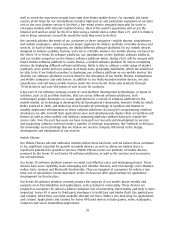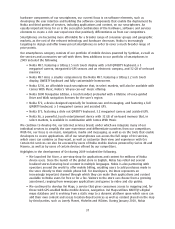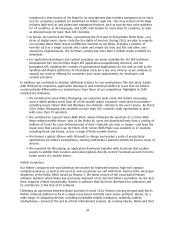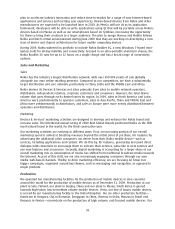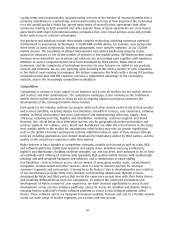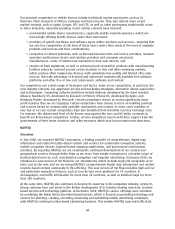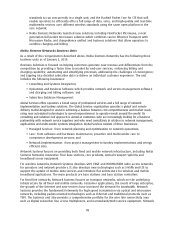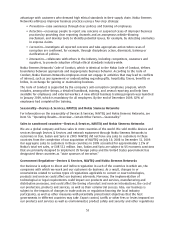Nokia 2009 Annual Report Download - page 45
Download and view the complete annual report
Please find page 45 of the 2009 Nokia annual report below. You can navigate through the pages in the report by either clicking on the pages listed below, or by using the keyword search tool below to find specific information within the annual report.royalty terms and proportionality: proportionality in terms of the number of essential patents that a
company contributes to a technology, and proportionality in terms of how important the technology
is to the overall product. Nokia has agreed upon terms of several license agreements with other
companies relating to both essential and other patents. Many of these agreements are crosslicense
agreements with major telecommunications companies that cover broad product areas and provide
Nokia with access to relevant technologies.
Our products and solutions include increasingly complex technology involving numerous patented,
standardized or proprietary, technologies. A 3G/WCDMA mobile device, for example, may incorporate
three times as many components, including substantially more complex software, as our 2G/GSM
mobile devices. The possibility of alleged infringement and related intellectual property claims
against us continues to rise as the number of entrants in the market grows, the Nokia product range
becomes more diversified, our products and solutions are increasingly used together with hardware,
software or service components that have been developed by third parties, Nokia enters new
businesses, and the complexity of technology increases. As new features are added to our products,
services and solutions, we are also agreeing upon licensing terms with a number of new companies
in the field of new evolving technologies. We believe companies like Nokia with a strong IPR position,
cumulative knowhow and IPR expertise can have a competitive advantage in the converging
industry, and in the increasingly competitive marketplace.
Competition
Competition is intense in every aspect of our business and across all markets for our mobile devices
and services and their combinations. The competitive landscape is also evolving as the traditional
mobile device market increases in maturity and as ongoing digital convergence promotes the
development of the converged mobile device market.
Participants in the industry continue to compete with each other mainly on the basis of their product
and services portfolio, including design, functionalities, breadth of services, user experience, software,
quality, technical performance and price; operational and manufacturing efficiency; supply chain
efficiency, including sourcing, logistics and distribution; marketing; customer support; and brand.
However, the critical factors that determine success vary by geographical market and product and
services segment. For instance, price, brand and distribution are often the critical factors in the entry
level market, while in the market for smartphones other factors may take on greater significance,
such as the ability of market participants to bring additional value to users of their devices through
services, including applications and content developed by themselves and/or by third parties, and the
quality of the overall user experience with their devices.
Nokia believes it has a number of competitive strengths, notably in its brand as well its scale, R&D
and software platforms, intellectual property and supply chain, including sourcing, production,
logistics and distribution. Building on these strengths, our aim has been, and continues to be, to have
an optimallysized offering of commercially appealing high quality mobile devices with aesthetically
pleasing and welldesigned hardware and software, and a combination of valueadding
functionalities—such as Internet access, various means of messaging, media, music, entertainment,
navigation, locationbased and other services—that are easy to discover and use for all major
consumer segments and price points. A strong focus for Nokia is also in developing the user interface
of our smartphones to make them more intuitive and providing addedvalue through services
developed by Nokia and third parties that enrich the experience people have with their Nokia device
and positively differentiate us from our competitors. To support the continued enrichment and
development of Nokia consumers’ user experience, we have invested significantly in research and
development across our four software platforms: Series 30, Series 40, Symbian and Maemo. Nokia is
merging Maemo with Intel’s Moblin software platform to create a new software platform called
MeeGo. These software assets are designed to balance usability, features and cost in a flexible manner
across our wide range of market segments, price points and user groups.
43




